Nothing changes the overall aesthetic of your kitchen better than updating the kitchen cabinets. But the type of cabinet finish you use can be a deal-breaker! It can make or break the cohesion of your kitchen design.
The kitchen cabinet market is growing at the fastest pace, with a market valuation of more than 160 billion in 2025. Likewise, the demand for kitchen cabinet finishes will grow exponentially.
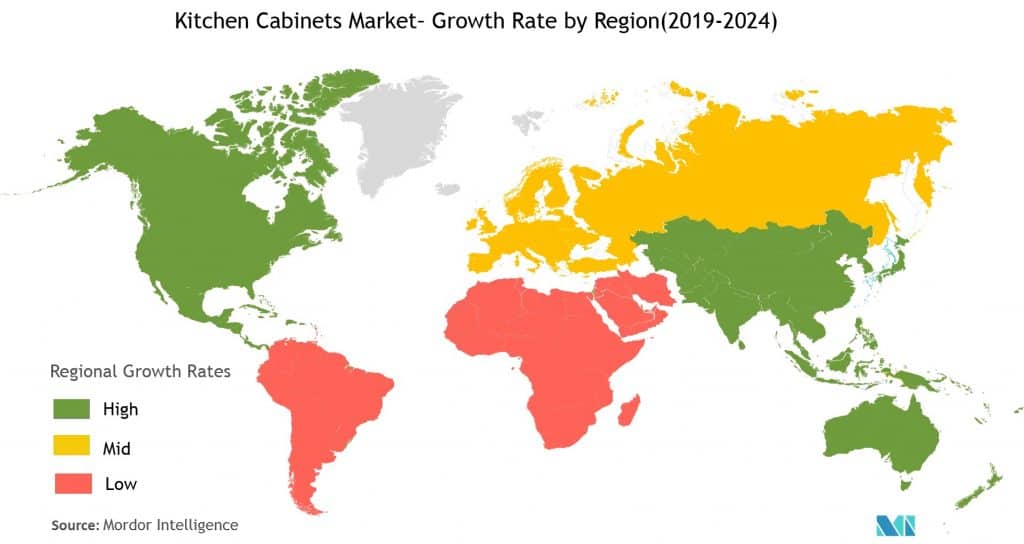
Image Source: www.mordorintelligence.com
Whether you are refinishing or refacing brand-new cabinets, this guide will help you understand the different types of kitchen cabinet finishes, plus their pros and cons.
JUMP TO: Natural | Waterborne UV finish | Painted | Stained | Veener | Matte | Glaze | Melamine | Acrylic | Lacquer | Laminate | Varnish | Gloss | Semi-Gloss | Polyurethane | Epoxy |
Natural
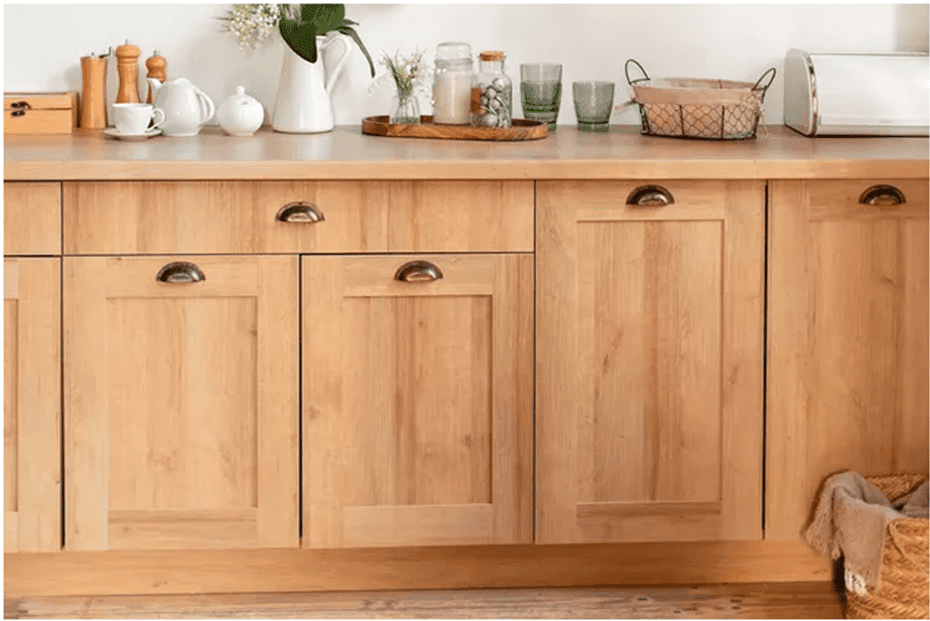
Source: iStockphotos.com
Natural cabinets are becoming a trend that is taking the market by storm. Their appearance is simple yet very beautiful.
Natural finishes are clear and protective and help to bring out the real color variations within the wood. You don’t use any dyes or stains.
Does this mean that natural cabinets look unpolished? Not at all!
Finishing involves sanding and oiling with mineral oil, linseed Tung, or mink. As such, they have a rustic appeal & charm and maintain uniformity & balance throughout the kitchen.
Although these cabinet finishes are considered long-lasting, it is essential to note that some woods are more durable than others. Consequently, be sure to do your research before purchasing wood for your kitchen cabinets.
Important tip: Natural wood is homogeneous. So, you will need the necessary design skills to coordinate a unified kitchen design plan and decorative aspects.
Pros
- Brings out the natural hues, patterns, and textures of the wood.
- Adds unique charm and beauty to your kitchen
- It pairs well with most design styles.
- Easy to refinish or resurface
Cons
- Natural finish is susceptible to discoloration and damage
- Lacks uniformity and color choice
- Hard to clean
Waterborne UV finish
Waterborne UV finish offers high-performance cabinets designed to reduce environmental impact.
It is formaldehyde-hazard-free, scratch-resistant, and has minimal volatile organic compounds.
Unlike most kitchen cabinet finishes, it has less downtime between application time and use.
It dries super-fast, then is cured with UV light. The result is amazing!
The aesthetic of waterborne finish is similar to that of stained, painted, or varnished cabinets.
Pros
- Scratch resistant
- Easy to clean
- Resists yellowing
Cons
- Slightly pricey
- Difficult to apply
Painted
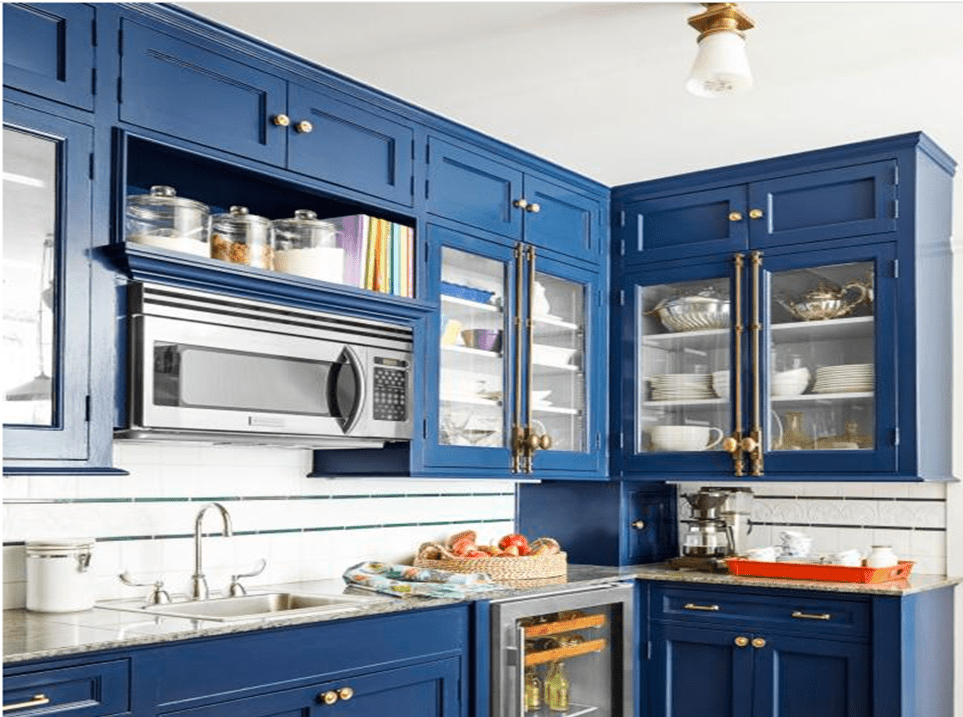
Source: hgtv.com
Are you looking to conceal wood grains and other imperfections on your kitchen cabinet material?
Consider a painted finish. Painted (opaque) cabinets come in a wide range of colors, making it easy to match any kitchen style.
The best thing about painting cabinets is that it gives you immense control/ freedom over the appearance of your kitchen.
The color of your kitchen cabinets enables you to design the rest of the kitchen. It also makes it easy to choose the type of cabinet appliances and décor suitable for the space.
According to research, 32% of homeowners prefer white cabinets, while 26% prefer medium brown.
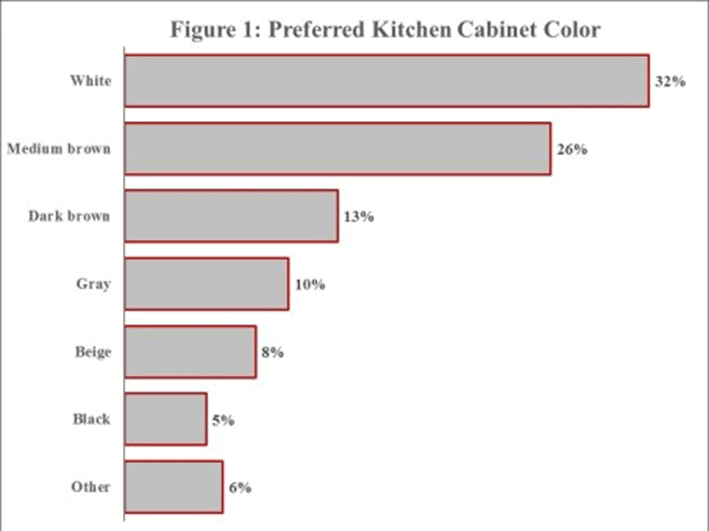
Source: eyeonhousing.org
Pros
- Hides imperfections in the wood
- Creates a seamless and uniform look
- Tons of colors to choose from
- It easily matches any style
Cons
- Prone to cracking, chipping, and peeling if not cared for properly.
- Some paint cabinet finishes can be hard to clean.
- It can be challenging for DIY. For best results, get a professional painter.
Stained
Staining is an excellent finish if you want to enhance the natural beauty of your kitchen wood cabinets. It is durable, affordable, and easy to use & maintain.
Cabinet stain comprises natural dyes and pigments. It can be solvent-based or water-based.
The stain finish soaks deep into the cabinet and becomes part of the wood. As a result, it does not peel or crack because it swells and shrinks with the wood.
Wood cabinets have different types of cabinet stain cabinet finish, each producing a unique appearance when applied on a surface.
The stain is easy to touch up if your cabinets discolor or chip. Better still, the stain rarely fades and is easy to clean.
According to research, stained cabinets are 10-15% less expensive than painted cabinets.
Pros
- Does not crack or peel
- Affordable
- Easy to clean and maintain
- Touch-up on the finish is possible
Cons
- It does not work well for MDF cabinets
- Staining can make blemishes on wood more pronounced.
Veneer

Source: snimayhome.com
Veneer finishes are almost similar to laminates. The only significant difference is that veneer is made from thin slices of natural wood, while the laminate is made from paper.
There are different types of veneer finishes, such as teak veneer and oak veneer. You can consider this finish if you want a natural wood appearance on your cabinets.
Related Read: Should Wall Color Match Kitchen Cabinets?
Pros
- Eco-friendly
- Flexibility in designs
- Non-toxic
Cons
- Requires installation by a professional
- Not repairable
- Susceptible to cracking
Matte
Matte finishes tend to absorb light rather than reflect it. They are perfect if you are looking for more muted-tone kitchen cabinets.
Since light does not bounce off the surfaces, the kitchen will have a subtle appeal. In addition, matte finishes have similar protective qualities as high gloss lacquer, only that they don’t show dirt and fingerprints as much.
This finish is more practical and perfect for a home with young kids.
Pros
- Excellent for covering imperfections
- Fingerprints are less visible
Cons
- It is not easy to clean
- Not the best for small kitchens as it won’t make the space feel bigger
Glaze

Source: rtacabinetstore.com
Consider finishing them with a glaze when staining or painting your kitchen cabinets. Apply a semi-transparent or transparent glaze over your cabinets, then wipe it off. The glaze settles into the cabinet’s details, bevels, and lines, leaving only a thin layer on the surface.
A glaze finish adds a rustic impression and antique look to the cabinets.
Adding a glaze finish to your cabinets is excellent if you want to highlight some details. For example, a hand-carved, intricate design on your kitchen cabinet door becomes more notable under a glazed finish.
Glazed cabinets match best with classic-styled or farmhouse kitchens. The additional depth and complexity of the finish cause it to stand out.
There are various glaze colors, both light and dark. There is also an accent glaze which you only apply on the details you want to highlight rather than the whole cabinet door.
Pros
- It gives cabinets a rustic look.
- It helps to highlight the unique details of cabinets
- Enhances the appearance of painted or stained cabinets
Cons
- The overall cost of glazing is high
- Time-consuming when it’s a DIY
- Pretty difficult to refinish or repair
Melamine
Melamine finishes are very versatile and durable. These kitchen cabinet finishes are applied on cabinets by sealing thermally fused melamine (TFM) using intense heat to plywood, MDF, pressed wood, or any other hardwood substrate.
The most amazing thing about the TFM is that it comes with a paper-like layer that you can print in any design or color of your choice. Also, the printed layer has a high-resolution image that delivers a 3D look.
You can use textured melamine to mimic real wood.
This finish forms a non-porous layer on your cabinet surface. The layer is stain-resistant, water-resistant, and easy to clean.
Also Read: Painted Vs. Thermofoil Cabinets [Explained with Pros + Cons]
Pros
- Extremely durable
- Available in a variety of colors and textures
- Easy to clean
- It forms a uniform, seamless look
Cons
- Prone to chipping
- Super heavy
Acrylic
Acrylic finish is comparable to lacquer in that it is shiny, non-toxic, and has a high gloss appearance.
It is available in a wide range of colors and gives your kitchen a mirror-like, seamless look.
Acrylic cabinets are excellent for high-end kitchens because of their luxurious appearance.
Pros
- They do not fade, tarnish or delaminate
- Scratch-resistant
- They have a soft, polished appearance
Cons
- It needs frequent cleaning as grime, stains, and fingerprints are more evident.
Lacquer
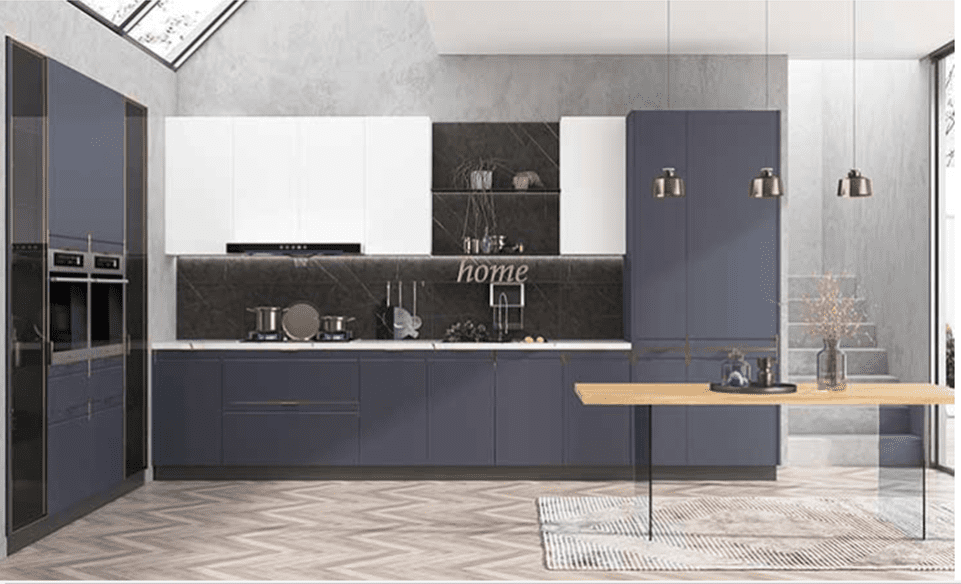
Source: oppoliahome.com
The lacquer finish is a solvent-based paint that leaves a firm, non-porous surface on your cabinets. You can either spray or brush it on, and it dries in about 15 minutes. This way, you can add multiple layers fast when doing a DIY project.
Once the finish dries, it leaves a smooth, even surface that is super-easy to clean.
This finish offers a long-lasting gloss on the cabinets. Besides, it is so durable and easy to apply.
Lacquered kitchen cabinets are available in matte, high gloss, and medium gloss. They come in varying hues and can fit any cabinet style.
Although this lacquer paint finish is durable, it can crack if the wood beneath is swollen from water leakage. These cabinets are not resistant to chemicals of any kind, including salty water.
Pros
- Versatile color options
- Easy to clean
- Smooth, even paint finish with no brush strokes
- Does not flake
Cons
- It can crack if the wood beneath it is swollen
- Susceptible to scratches, stains, and dents
- Requires frequent refinishing
Laminate
The laminate finish is a cost-effective, durable option for kitchen cabinets. The laminate is hot-pressed to remove bubbles and air from the shutters to prevent sharp corners.
Then, edge banding with the same color laminate is applied to the cabinet corners to prevent the edges from chipping off. `
Laminate cabinets have two options to choose from matte and high gloss. Besides, more durable laminate varieties for kitchen cabinets have been introduced in the market. These include Thermal Structured Surface (TSS) and porta door style, commonly known as PET.
You can get laminate in any color and one that mimics the look of wood.
Pros
- Highly durable
- Available in a wide range of styles
- Affordable
Cons
- Heavy and difficult to install
- Cannot be repaired if damaged
Varnish
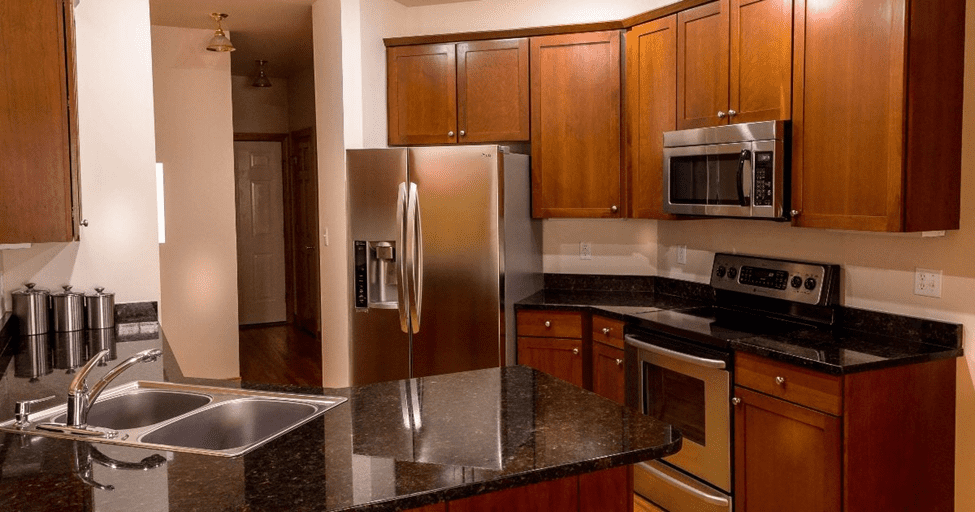
Source: overstock.com
Almost all kitchen cabinets have varnish on them.
Varnish is a clear top coat applied to cabinets to increase their durability. It forms a hard, protective layer when it dries.
The common types of varnishes are conversion and polyurethane. Conversion is the most durable of the two.
Pros
- ance of wood without covering the grains
- Protects wood from water, sunlight, and dirt
- It brings out the most natural wood appearance
Cons
- come yellow or dull with time
- Low resistance to wear and tear
Gloss
Gloss cabinets have a shiny surface that gives them a very contemporary look. For better results, many homeowners prefer glossy white cabinets. It makes your kitchen appear larger.
Moreover, gloss cabinets reflect a lot of light, thanks to their smooth surface.
Pros
- a sleek and stylish look
- makes the room look and feel bigger
- dirt and food splashes can’t stick on the surface
Cons
- need cleaning more often
- easy to scratch
- light reflection can lead to brighter and darker areas
Semi-Gloss
Semi-gloss kitchen cabinet finishes appear shinier than satin. Most importantly, their luster is more constant.
They give your kitchen a bright appearance. However, they tend to outshine the base color of your kitchen. Consequently, a semi-gloss paint finish may not be ideal for every project.
Pros
- resistant to smudges, scratches, and dents
- durable
- water- and mildew-resistant
Cons
- dents, scratches, and dings are hard to see
- less DIY-friendly
Polyurethane
Polyurethane is one of the top-tier kitchen cabinet finishes. It features a paint mixture of a hardener plus satin.
Many homeowners express their satisfaction with polyurethane thanks to its high durability. According to reviews, it’s also hard to scratch, making it a favorite to many users.
Additionally, this paint finish can fit almost any kitchen style. As such, you can opt for it whether you have a contemporary or traditional design.
Pros
- water-resistant)
- very durable
- attractive
- scratch resistant
Cons
- doesn’t spray well
- picks up dust nibs as it dries
Epoxy
It is a latex acrylic product with a nice, appealing shine. It is also durable and has a tough, protective coating resistant to corrosion and chemicals.
The epoxy finish gives your cabinets a nice appealing finish. Its popularity also stems from its being highly durable and tough, even against corrosive chemicals.
However, customer reviews show that its high cost prohibits most homeowners from using it. According to research, epoxy paint finish costs between $40 and $200 a gallon, which is quite high.
Pros
- heat-resistant
- food-safe and non-toxic
- simple to clean
Cons
- needs an expert for better results
![What Is Kitchen Cabinet Refacing? [Pros and Cons + Cost Analysis] What Is Kitchen Cabinet Refacing? [Pros and Cons + Cost Analysis]](https://houseadorable.com/wp-content/uploads/2022/04/Refacing.jpg)
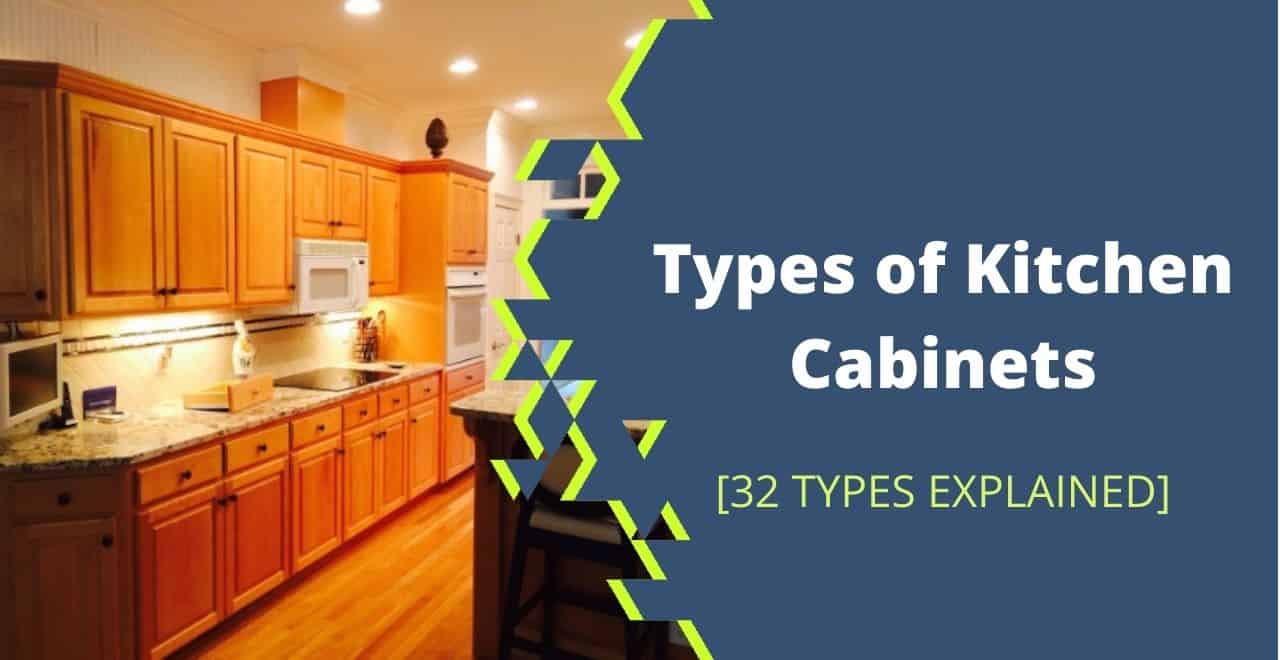
![How Long Does it Take to Install Kitchen Cabinets? [Steps Explained] How Long Does it Take to Install Kitchen Cabinets? [Steps Explained]](https://houseadorable.com/wp-content/uploads/2022/07/kitchen-cabinet-installation.jpg)
![16 Types of Kitchen Faucets Explained [With Pros + Cons] 16 Types of Kitchen Faucets Explained [With Pros + Cons]](https://houseadorable.com/wp-content/uploads/2023/02/Roca_griferia_cocina_mencia_negro_DEF_900x505_acf_cropped-1@2x-250x250.jpg)
![Gloss Vs. Matte Kitchen Cabinets [7 Key Differences Explained] Gloss Vs. Matte Kitchen Cabinets [7 Key Differences Explained]](https://houseadorable.com/wp-content/uploads/2022/12/white-high-gloss.jpg)
![Granite Vs. Marble Vs. Quartz Countertops [12 Differences+Pros & Cons] Granite Vs. Marble Vs. Quartz Countertops [12 Differences+Pros & Cons]](https://houseadorable.com/wp-content/uploads/2022/03/quartz-marble.jpg)
![How to Choose Kitchen Cabinets [9 Important Tips Included] How to Choose Kitchen Cabinets [9 Important Tips Included]](https://houseadorable.com/wp-content/uploads/2022/10/kitchen.jpg)
![[A] Water Heater Not Heating After Replacing Elements and Thermostat [A] Water Heater Not Heating After Replacing Elements and Thermostat](https://houseadorable.com/wp-content/uploads/2023/08/water-heater-not-heating-after-replacing-elements-1-250x250.png)